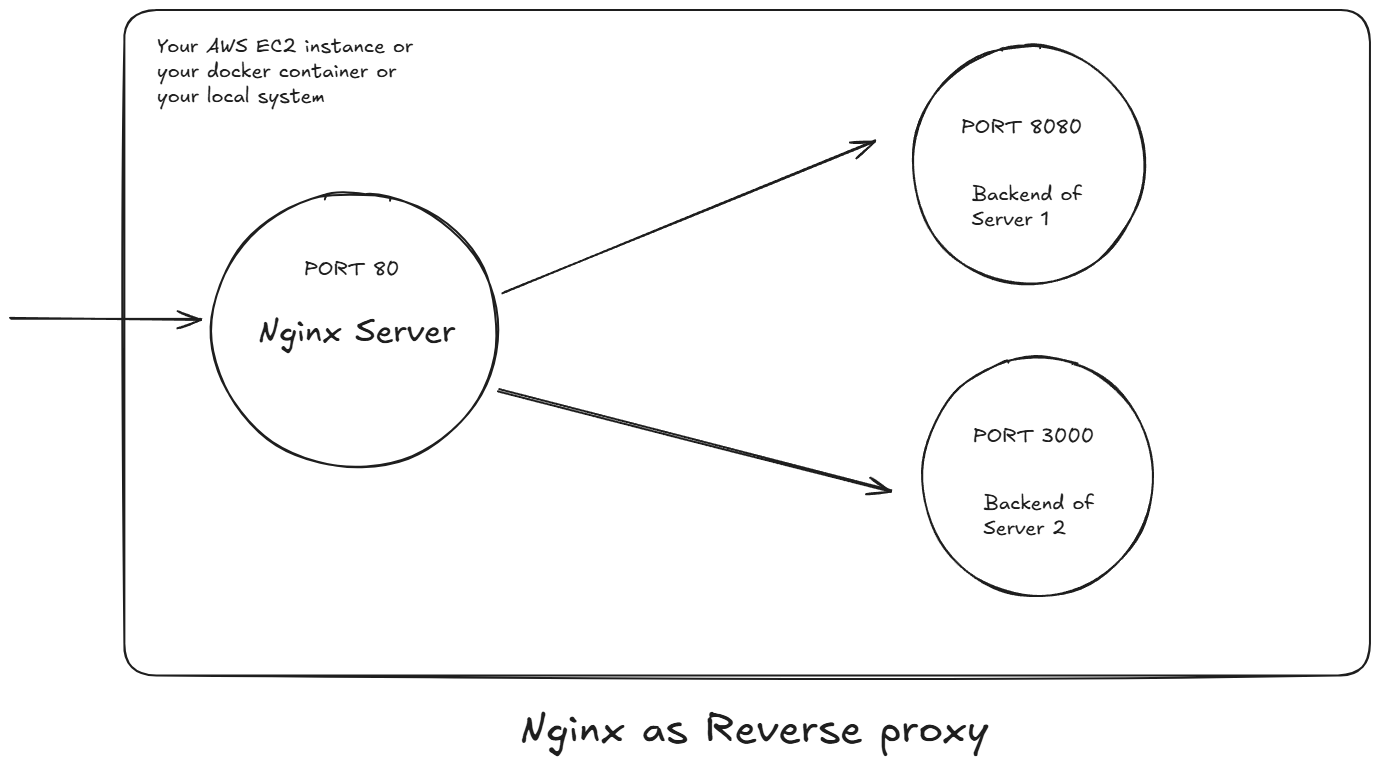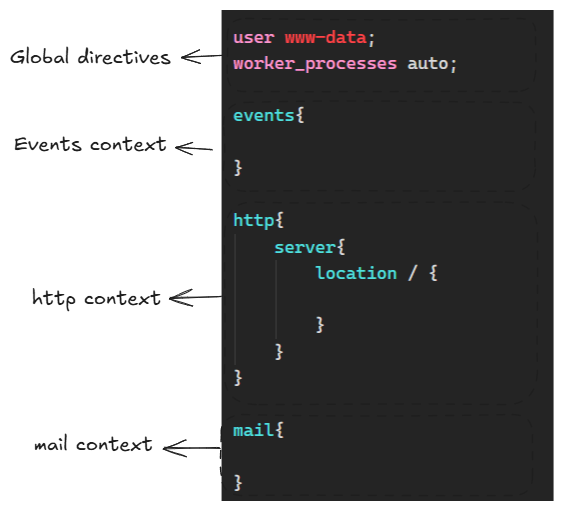Beginner's Guide to Nginx
 Ashutosh Verma
Ashutosh Verma
Nginx (pronounced "engine-x") is a high-performance, open-source web server and reverse proxy server. It is widely used for serving static and dynamic content, handling reverse proxying, load balancing, and acting as an API gateway.
Why is Nginx Used?
Nginx is popular because of its:
High Performance – Handles thousands of connections with low memory usage.
Reverse Proxy – Forwards client requests to backend servers (e.g., Node.js, Python, PHP).
Load Balancing – Distributes traffic among multiple servers.
Security Features – Blocks malicious traffic, prevents DDoS attacks.
Static File Serving – Efficiently serves HTML, CSS, JS, images, etc.
SSL/TLS Support – Secures websites with HTTPS.
Caching – Improves website speed by storing frequently accessed content.
You will mainly use it as Reverse proxy, API gateway, load balancing and for managing SSL certificates
How Nginx Works?
A user sends a request to a domain (e.g.,
example.com).The request reaches Nginx, which decides how to handle it:
If it’s for static content, Nginx serves it directly.
If it’s for dynamic content, Nginx forwards it to a backend (e.g., Node.js running on port 3000).
If configured as a reverse proxy, Nginx acts as an intermediary between clients and backend servers.
If acting as a load balancer, Nginx distributes traffic across multiple backend servers.
It logs requests, applies security rules, and optimizes performance.

By default nginx server runs on port 80 which is a http port. So if you are running nginx on your local system then it will run 127.0.0.1 If you visit 127.0.0.1 in your browser then you will see default nginx page.
Installing Nginx
1. Installing it locally on your system
https://nginx.org/en/download.html
2. Installing it in a Docker container.
You should have docker installed in your machine.
1. Pull the Official Nginx Docker Image
docker pull nginx
This downloads the latest official Nginx image from Docker Hub.
2. Run Nginx Container
docker run --name my-nginx -d -p 80:80 nginx
Explanation:
docker run→ Runs a new container--name my-nginx→ Assigns a custom name to the container-d→ Runs in detached mode (in the background)-p 80:80→ Maps container port 80 to host port 80nginx→ Uses the nginx image
Now, open http://localhost in a browser, and you should see the default Nginx welcome page.
3. Check Running Containers
docker ps
To see all containers (including stopped ones):
docker ps -a
4. Stop, Start, and Restart Nginx Container
Stop Nginx container
docker stop my-nginx
Start Nginx container
docker start my-nginx
Restart Nginx container
docker restart my-nginx```
5. Customize Nginx Configuration
To use a custom nginx.conf, create a directory and file:
mkdir ~/nginx
cd ~/nginx
nano nginx.conf
Paste a simple config:
events { worker_connections 1024; }
http {
server {
listen 80;
server_name localhost;
location / {
root /usr/share/nginx/html;
index index.html;
}
}
}
Run the container with your custom config:
docker run --name my-nginx -d -p 80:80 -v ~/nginx/nginx.conf:/etc/nginx/nginx.conf nginx
6. Remove Nginx Container
To stop and remove the container:
docker stop my-nginx
docker rm my-nginx
Summary of Key Commands
| Command | Purpose |
docker pull nginx | Download Nginx image |
docker run --name my-nginx -d -p 80:80 nginx | Start Nginx container |
docker ps | List running containers |
docker stop my-nginx | Stop Nginx container |
docker start my-nginx | Start the stopped container |
docker restart my-nginx | Restart the container |
docker rm my-nginx | Remove the container |
3. Installing it on Linux server.
Nginx can be installed on different Linux distributions like Ubuntu, Debian, CentOS, RHEL, and Arch Linux. Below are the step-by-step installation instructions.
1. Update Your System Packages
Before installing Nginx, update the system package list.
sudo apt update && sudo apt upgrade -y # For Ubuntu/Debian
sudo yum update -y # For CentOS/RHEL
2. Install Nginx
For Ubuntu/Debian
sudo apt install nginx -y
3. Start and Enable Nginx Service
After installation, start and enable Nginx to launch automatically on system boot using [[Advance Linux commands#How to manage systemd services?|systemctl]]
sudo systemctl start nginx # Start Nginx
sudo systemctl enable nginx # Enable auto-start on boot
To check if Nginx is running:
sudo systemctl status nginx
4. Allow Nginx Through Firewall (If Enabled)
If a firewall is enabled, allow Nginx traffic.
For UFW (Ubuntu/Debian)
sudo ufw allow 'Nginx Full'
sudo ufw reload
sudo ufw status
5. Verify Installation
To check if Nginx is installed and running, open a web browser and visit:
http://YOUR_SERVER_IP
If you see the "Welcome to Nginx" page, Nginx is installed and running successfully.
You can also test it from the terminal:
curl -I http://localhost
Expected output:
HTTP/1.1 200 OK
...
Server: nginx/1.x.x
6. Manage Nginx Service
| Command | Description |
sudo systemctl start nginx | Start Nginx |
sudo systemctl stop nginx | Stop Nginx |
sudo systemctl restart nginx | Restart Nginx |
sudo systemctl reload nginx | Reload config without restarting |
sudo systemctl enable nginx | Enable Nginx to start on boot |
sudo systemctl disable nginx | Disable Nginx from starting on boot |
Nginx configuration
Nginx's configuration file (nginx.conf) controls how the web server behaves, manages connections, and processes requests. Below, I'll explain its structure and key directives.
Location: - /etc/nginx/nginx.conf
To edit the configuration file:
sudo cat /etc/nginx/nginx.conf
After making changes, reload Nginx:
sudo systemctl reload nginx
2. Nginx Configuration Structure

A basic nginx.conf looks like this:
user www-data;
worker_processes auto;
events{
}
http{
server{
location / {
}
}
}
mail{
}
user www-data;
worker_processes auto;
events {
worker_connections 1024;
}
http {
include mime.types;
default_type application/octet-stream;
sendfile on;
keepalive_timeout 65;
server {
listen 80;
server_name example.com;
location / {
root /var/www/html;
index index.html index.htm;
}
error_page 404 /404.html;
location = /404.html {
root /var/www/html;
}
}
}
3. Breakdown of Configuration Sections
1️⃣ Global Settings
These are at the top level of nginx.conf and apply to the whole server.
| Directive | Description |
user www-data; | Defines the user under which Nginx runs (default: www-data on Ubuntu). |
worker_processes auto; | Defines how many worker processes to run. auto lets Nginx decide based on CPU cores. |
2️⃣ events {} Block
This section handles connection-related settings.
| Directive | Description |
worker_connections 1024; | Sets the maximum number of simultaneous connections a worker can handle. |
multi_accept on; | (Optional) Allows workers to accept multiple new connections at a time. |
3️⃣ http {} Block
This section manages HTTP-related settings, including MIME types, logging, and request handling. Http block can have single or multiple server block.
| Directive | Description |
include mime.types; | Specifies file types Nginx should recognize. |
default_type application/octet-stream; | Default type for unknown file extensions. |
sendfile on; | Optimizes file sending to improve performance. |
keepalive_timeout 65; | Time (in seconds) a connection remains open for multiple requests. |
4️⃣ server {} Block
Each server {} block defines a virtual host (website) in Nginx.
| Directive | Description |
listen 80; | Listens on port 80 (HTTP). |
server_name example.com; | Specifies the domain name for this server block. |
root /var/www/html; | Defines the root directory for website files. |
index index.html index.htm; | Sets the default homepage files. |
error_page 404 /404.html; | Specifies a custom error page for 404 errors. |
5️⃣ location {} Blocks
These define request-handling rules.
| Directive | Description |
location / {} | Defines how requests to / (root URL) are handled. |
location = /404.html {} | The = means an exact match for /404.html. |
location ~ \.php$ {} | The ~ means a regex match for .php files. |
4. Advanced Configurations
🔹 Reverse Proxy Example
If you have an app running on port 3000, you can set up a reverse proxy:
server {
listen 80;
server_name example.com;
location / {
proxy_pass http://localhost:3000;
proxy_set_header Host $host;
proxy_set_header X-Real-IP $remote_addr;
proxy_set_header X-Forwarded-For $proxy_add_x_forwarded_for;
}
}
Now, requests to http://example.com will be forwarded to http://localhost:3000.
🔹 Load Balancing Example
If you have multiple backend servers, you can distribute requests:
upstream backend_servers {
server backend1.example.com;
server backend2.example.com;
}
server {
listen 80;
server_name example.com;
location / {
proxy_pass http://backend_servers;
}
}
5. Managing Nginx
| Command | Description |
sudo systemctl start nginx | Start Nginx |
sudo systemctl stop nginx | Stop Nginx |
sudo systemctl restart nginx | Restart Nginx |
sudo systemctl reload nginx | Reload config without downtime |
sudo nginx -t | Test config for errors |
Subscribe to my newsletter
Read articles from Ashutosh Verma directly inside your inbox. Subscribe to the newsletter, and don't miss out.
Written by

Ashutosh Verma
Ashutosh Verma
I’m a full-stack developer passionate about building innovative web applications. I have experience in real-time collaboration tools, cloud computing, and scalable backend systems. I love sharing my journey, learnings, and insights on my blog, v8coder.com.